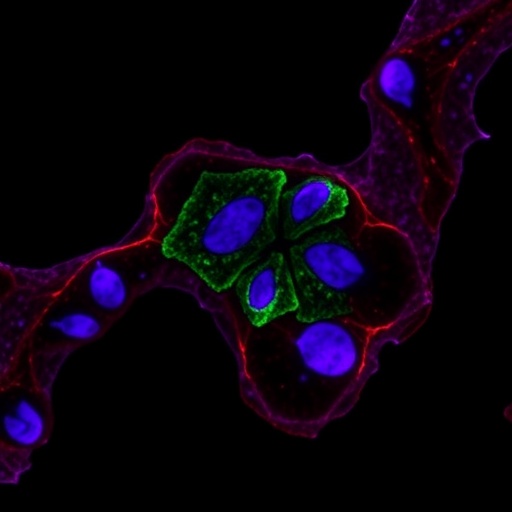Recent advancements in reproductive biology have unveiled the remarkable potential of the Notch signaling pathway to ameliorate conditions associated with premature ovarian failure (POF). In a groundbreaking study led by researchers Liang, Li, and Wu, a pivotal role of Notch2 has been elucidated, portraying it as a crucial player in enhancing granulosa cell functions. The repercussions of this research are significant for women facing reproductive challenges due to POF, urging a deeper understanding of the underlying mechanisms that govern ovarian health.
As the scientific community continues to explore the intricacies of reproductive health, the role of granulosa cells has garnered attention. These ovarian follicular cells are integral to the formation and maturation of oocytes, and their functionality is paramount for successful ovulation. In cases of premature ovarian failure, granulosa cells often exhibit dysfunction, leading to suboptimal hormonal production and poor oocyte quality. This research highlights Notch2 as a promoter of granulosa cell health, potentially reversing the detrimental effects of POF.
The Notch signaling pathway is a well-established intercellular communication system that plays a key role in cell differentiation, proliferation, and apoptosis. Within the context of ovarian physiology, the activation of this pathway can invigorate granulosa cells, thereby enhancing their capacity to support oocyte development. The researchers aimed to delve into how Notch2 activation might contribute to the restoration of these crucial cells, imparting a sense of hope for therapeutic interventions in managing POF.
Central to this investigation was the Wnt2/β-catenin signaling pathway, which operates in tandem with Notch. The interplay of these two pathways is critical, as Wnt2 signaling is known to influence various cellular functions, including proliferation and differentiation. The researchers posited that activating Notch2 could synergistically enhance Wnt2/β-catenin signaling, leading to improved granulosa cell function. This finding adds another layer of complexity to our understanding of ovarian biology, proposing a dual signaling mechanism that may be targeted for therapeutic gain.
To elucidate the mechanisms involved, the study employed an array of experimental methodologies, incorporating both in vitro and in vivo models. Granulosa cells isolated from ovaries of POF models were treated with Notch2 agonists, allowing researchers to observe significant changes in gene expression profiles. Enhanced markers of granulosa cell vitality, such as increased hormone production and improved cell viability, were noted, indicating that Notch2 activation could effectively rejuvenate failing ovarian follicles.
Furthermore, data generated from Western blot analyses supported the hypothesis that Notch2 activation promotes the expression of Wnt2 and its downstream effector, β-catenin. The observed upregulation of β-catenin suggests that enhanced Wnt signaling could be contributing to the observed improvements in granulosa cell functions. This provides a compelling link between Notch signaling and the modulation of developmental processes within the ovarian environment, suggesting avenues for targeted therapies aimed at restoring ovarian function in women experiencing POF.
A crucial aspect of this research was the exploration of potential clinical applications stemming from these findings. The promise of harnessing Notch2 signaling presents exciting possibilities for developing novel treatments aimed at rejuvenating the ovarian reserve and improving fertility outcomes for women suffering from premature ovarian failure. As current therapies are limited in effectiveness, this new insight into Notch2 could position it as a target for pharmacological interventions.
The findings were then contextualized within the broader framework of reproductive endocrinology, raising important questions about how these molecular mechanisms could be translated into real-world applications. While the path from laboratory discovery to clinical application is often complex, the compelling nature of this research could lead to innovative therapeutic strategies that leverage the power of the Notch-Wnt signaling nexus.
Importantly, the implications of this research extend beyond individual treatment approaches; they may shape our understanding of ovarian aging and reproductive health preservation. As the global population ages, understanding the biological underpinnings of ovarian function becomes increasingly critical. Continued research in this area could yield significant insights, enabling physicians to better gauge and intervene in age-related fertility decline.
Moreover, understanding the interaction between Notch signaling and environmental factors—such as nutrition, lifestyle, and endocrine disruptors—can further enrich our understanding of ovarian health. The bi-directional relationship between signaling pathways, cell environment, and reproductive outcomes paints a complex picture necessitating comprehensive and multifaceted approaches to treatment.
As more studies build upon this foundation, the challenge will be to translate bench research into bedside applications. Regulatory hurdles and the need for rigorous clinical trials remain paramount. Nevertheless, the hope is that this pioneering research will inspire further investigation, ultimately leading to therapies that can meaningfully impact the lives of women facing the daunting diagnosis of premature ovarian failure.
In conclusion, the study led by Liang, Li, and Wu establishes Notch2 as a key regulator in supporting granulosa cell functions and potentially offers a route towards innovative treatments for premature ovarian failure. The interplay between Notch2 and the Wnt2/β-catenin pathway underscores a multifaceted approach to understanding reproductive health, and future studies are likely to illuminate further avenues for exploration. By fostering this dialogue within the scientific community, there is potential for significant advancements in the care and support of women experiencing reproductive challenges.
Subject of Research: Notch2 activation in granulosa cells and its effects on premature ovarian failure.
Article Title: Notch2 improves granulosa cell functions in premature ovarian failure by activating the Wnt2/β-catenin pathway.
Article References:
Liang, X., Li, N. & Wu, S. Notch2 improves granulosa cell functions in premature ovarian failure by activating the Wnt2/β-catenin pathway.
J Ovarian Res 18, 169 (2025). https://doi.org/10.1186/s13048-025-01745-9
Image Credits: AI Generated
DOI: 10.1186/s13048-025-01745-9
Keywords: Notch2, granulosa cells, premature ovarian failure, Wnt2, β-catenin, reproductive health, ovarian biology, signaling pathways, fertility.




